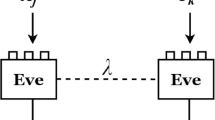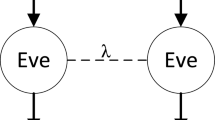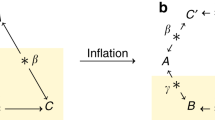Abstract
Bell tests, as primitive tools to detect nonlocality in bipartite systems, rely on an assumption, i.e., measurement independence. In practice, it is difficult to ensure measurement independence. It is necessary to investigate how Bell tests are affected by relaxing measurement independence. In the simplest (2, 2, 2) CHSH Bell test which consists of two parties, two measurements per party and two possible outcomes per measurement, the results between the maximal value of CHSH correlation function and distributed measurement dependence (DMD) are given, where DMD is a general measure of relaxing measurement independence. However, in a general Bell scenario of an arbitrary number of measurements per party, i.e., (2, N, 2), pertinent results are still missing. To solve it, we establish the relations between the maximal value of (2, N, 2) Pearle–Braunstein–Caves (PBC) chain correlation function that maintains the locality and the degree of DMD, denoted as DMD-induced PBC chain inequalities. Furthermore, we show the tightness of these derived inequalities via constructing local hidden variable models that fake the upper bounds. Compared with the simplest CHSH Bell test, our derived inequalities need less amount of measurement dependence to fake the quantum prediction with N increasing, which is beneficial to analyze the security of device-independent quantum information processing tasks such as randomness expansion.





Similar content being viewed by others
References
Popescu, S., Rohrlich, D.: Quantum nonlocality as an axiom. Found. Phys. 24, 379 (1994)
Barrett, J., Linden, N., Massar, S., Pironio, S., Popescu, S., Roberts, D.: Nonlocal correlations as an information-theoretic resource. Phys. Rev. A 71, 022101 (2005)
Gallego, R., Würflinger, L.E., Acín, A., Navascués, M.: Operational framework for nonlocality. Phys. Rev. Lett. 109, 070401 (2012)
Christensen, B.G., Liang, Y.C., Brunner, N., Gisin, N., Kwiat, P.G.: Exploring the limits of quantum nonlocality with entangled photons. Phys. Rev. X 5, 041052 (2015)
Acín, A., Gisin, N., Masanes, L.: From Bell’s theorem to secure quantum key distribution. Phys. Rev. Lett. 97, 120405 (2006)
Vazirani, U., Vidick, T.: Fully device-independent quantum key distribution. Phys. Rev. Lett. 113, 140501 (2014)
Vazirani, U., Vidick, T.: Fully device independent quantum key distribution. Commun. ACM 62(4), 133 (2019)
Pironio, S., Acín, A., Massar, S., de la Giroday, A.B., Matsukevich, D.N., Maunz, P., Olmschenk, S., Hayes, D., Luo, L., Manning, T.A., Monroe, C.: Random numbers certified by Bell’s theorem. Nature (London) 464, 1021 (2010)
Colbeck, R., Kent, A.: Private randomness expansion with untrusted devices. J. Phys. A Math. Theor. 44(9), 095305 (2011)
Pironio, S., Massar, S.: Security of practical private randomness generation. Phys. Rev. A 87, 012336 (2013)
Fehr, S., Gelles, R., Schaffner, C.: Security and composability of randomness expansion from Bell inequalities. Phys. Rev. A 87, 012335 (2013)
Acín, A., Masanes, L.: Certified randomness in quantum physics. Nature 540(7632), 213 (2016)
Huang, X.H., Li, D.D., Zhang, P.: Effects of measurement dependence on tilted CHSH Bell tests. Quantum Inf. Process. 17(11), 291 (2018)
Bouda, J., Pawłowski, M., Pivoluska, M., Plesch, M.: Device-independent randomness extraction from an arbitrarily weak min-entropy source. Phys. Rev. A 90, 032313 (2014)
Yang, T.H., Vértesi, T., Bancal, J.D., Scarani, V., Navascués, M.: Robust and versatile black-box certification of quantum devices. Phys. Rev. Lett. 113, 040401 (2014)
Wu, X., Bancal, J.D., McKague, M., et al.: Device-independent parallel self-testing of two singlets. Phys. Rev. A 93(6), 062121 (2016)
Kaniewski, J.: Analytic and nearly optimal self-testing bounds for the Clauser–Horne–Shimony–Holt and Mermin inequalities. Phys. Rev. Lett. 117(7), 070402 (2016)
Bell, J.S.: On the Einstein Podolsky Rosen paradox. Physics 1, 3 (1964)
Bell, J.S.: Speakable and Unspeakable in Quantum Mechanics. Cambridge University Press, Cambridge (2004)
Clauser, J.F., Horne, M.A., Shimony, A., Holt, R.A.: Proposed experiment to test local hidden-variable theories. Phys. Rev. Lett. 23, 880 (1969)
Wehner, S.: Tsirelson bounds for generalized Clauser–Horne–Shimony–Holt inequalities. Phys. Rev. A 73, 022110 (2006)
Dhara, C., de la Torre, G., Acín, A.: Can observed randomness be certified to be fully intrinsic? Phys. Rev. Lett. 112, 100402 (2014)
Barrett, J., Gisin, N.: How much measurement independence is needed to demonstrate nonlocality? Phys. Rev. Lett. 106, 100406 (2011)
Pütz, G., Rosset, D., Barnea, T.J., Liang, Y.C., Gisin, N.: Arbitrarily small amount of measurement independence is sufficient to manifest quantum nonlocality. Phys. Rev. Lett. 113, 190402 (2014)
Hall, M.J.W.: Local deterministic model of singlet state correlations based on relaxing measurement independence. Phys. Rev. Lett. 105, 250404 (2010)
Hall, M.J.W.: Relaxed Bell inequalities and Kochen–Specker theorems. Phys. Rev. A 84, 022102 (2011)
Thinh, L.P., Sheridan, L., Scarani, V.: Bell tests with min-entropy sources. Phys. Rev. A 87, 062121 (2013)
Colbeck, R., Renner, R.: Free randomness can be amplified. Nat. Phys. 8, 450 (2012)
Gallego, R., Masanes, L., De La Torre, G., Dhara, C., Aolita, L., Acín, A.: Full randomness from arbitrarily deterministic events. Nat. Commun. 4, 2654 (2013)
Koh, D.E., Hall, M.J.W., Setiawan Pope, J.E., Marletto, C., Kay, A., Scarani, V., Ekert, A.: Effects of reduced measurement independence on Bell-based randomness expansion. Phys. Rev. Lett. 109, 160404 (2012)
Friedman, A.S., Guth, A.H., Hall, M.J.W., Kaiser, D.I., Gallicchio, J.: Relaxed Bell inequalities with arbitrary measurement dependence for each observer. Phys. Rev. A 99, 012121 (2019)
Banik, M., Gazi, M.D.R., Das, S., et al.: Optimal free will on one side in reproducing the singlet correlation. J. Phys. A Math. Theor. 45, 205301 (2012)
Franson, J.D.: Bell inequality for position and time. Phys. Rev. Lett. 62, 2205 (1989)
Aerts, S., Kwiat, P., Larsson, J.-A., Zukowski, M.: Two-photon Franson-type experiments and local realism. Phys. Rev. Lett. 83, 2872 (1999)
Barrett, J., Colbeck, R., Kent, A.: Unconditionally secure device-independent quantum key distribution with only two devices. Phys. Rev. A 86, 062326 (2012)
Li, D.D., Zhou, Y.Q., Gao, F., Li, X.H., Wen, Q.Y.: Effects of measurement dependence on generalized Clauser–Horne–Shimony–Holt Bell test in the single-run and multiple-run scenarios. Phys. Rev. A 94, 012104 (2016)
Acknowledgements
This work was supported by NSFC (Grant Nos. 61802023, 61701553).
Author information
Authors and Affiliations
Corresponding author
Additional information
Publisher's Note
Springer Nature remains neutral with regard to jurisdictional claims in published maps and institutional affiliations.
Appendix
Appendix
In order to prove the tightness of the derived results of Theorem 2, here, without loss of generality, we discuss the case of \(N=3, \delta _A=\delta _B=1, \xi _A= \xi _B=1\), and other cases can be proved similarly.
For achieving the maximal value of PBC chain correlation function via local hidden variable model, then Eqs. (43), (44), (46) must hold “=.” Let absolute values of Eqs. (43), (44), (46) be themselves. Based on the product of definite outcomes of Alice and Bob (i.e, Table 5), then \(p(\lambda |X_{0}Y_{0})-p(\lambda |X_{0}Y_{2})\), \(p(\lambda |X_{1}Y_{1})-p(\lambda |X_{1}Y_{0})\), \(p(\lambda |X_{2}Y_{2})-p(\lambda |X_{2}Y_{1})\), \(p(\lambda |X_{1}Y_{0})-p(\lambda |X_{0}Y_{0})\) and \(p(\lambda |X_{2}Y_{1})-p(\lambda |X_{1}Y_{1})\) need to satisfy the following relations:
In order to enforce to satisfy these conditions, we parameterize the conditional probabilities in Table 6.
When \({{\hat{M}}}_{A}=M_{A}\) and \({{\hat{M}}}_{B}=M_{B}\), the result under four-parameter description is reduced to the result under two-parameter description. If the upper bound of \(\hbox {DMD}_2\)-induced PBC chain inequality is achieved, then the values of \(f_{s} (s\in \{1,\ldots , 36\})\) which consist of \(\{p(\lambda |X_j, Y_k)\}\) are given in the following:
In the case of distributed measurement dependence with four-parameter description, if \(\delta _A=\delta _B=1, \xi _A=\xi _B=1\), let \(M_{B}[X_j]\), \(M_{A}[Y_k]\) satisfy the following constraints:
where \(j, k\in \{0, 1, 2\}\).
Based on the normalization of probability and the expression of \(I^\mathrm{PBC}_{N=3}\), \(I^\mathrm{PBC}_{N=3}\) is deduced as
\(I^\mathrm{PBC}_{N=3}\) is required to achieve the upper bound (i.e., \(4+{{\hat{M}}}_{A}+{{\hat{M}}}_{B}+ M_{A}+2M_{B}\) ); then, we have
Based on the normalization of \(\{p(\lambda |X_1,Y_0)\}\), we get
Based on the constraints of Eq. (66) and the normalization of probability, we get
Combing with Eq. (65), by solving Eq. (70) we get the values of \(f_{s} (s\in \{1,\cdots , 36\})\) in the following:
Relying on Eq. (71), each element of Table 4 is given. Hence, we complete the entities of Table 4 under conditions of \(M_A\ge M_B\), \({{\hat{M}}}_A+{{\hat{M}}}_B+M_A+2M_B\le 2\), \({{\hat{M}}}_A \ge M_B\) and \(-M_A+M_B+2{{\hat{M}}}_A -2 {{\hat{M}}}_B \ge 0\).
When \({{\hat{M}}}_A+{{\hat{M}}}_B+M_A+2M_B>2\), the calculation of the values of \(p(\lambda |X_j,Y_k)\) is similar to the case of \({{\hat{M}}}_A+{{\hat{M}}}_B+M_A+2M_B\le 2\). The difference between the case of \({{\hat{M}}}_A+{{\hat{M}}}_B+M_A+2M_B>2\) and the case of \({{\hat{M}}}_A+{{\hat{M}}}_B+M_A+2M_B\le 2\) is the relation deduction of \(\{f_s\}\) in case of \({{\hat{M}}}_A=M_A\) and \({{\hat{M}}}_B=M_B\) and calculation about \(\{f_s\}\) in case of \({{\hat{M}}}_A, M_A, {{\hat{M}}}_B, M_B\). However, the deduction methods are similar to the case of \({{\hat{M}}}_A+{{\hat{M}}}_B+M_A+2M_B\le 2\) and omitted.
Rights and permissions
About this article
Cite this article
Li, DD., Chen, LY., Cao, Y. et al. The effect on (2, N, 2) Bell tests with distributed measurement dependence. Quantum Inf Process 19, 339 (2020). https://doi.org/10.1007/s11128-020-02819-x
Received:
Accepted:
Published:
DOI: https://doi.org/10.1007/s11128-020-02819-x




